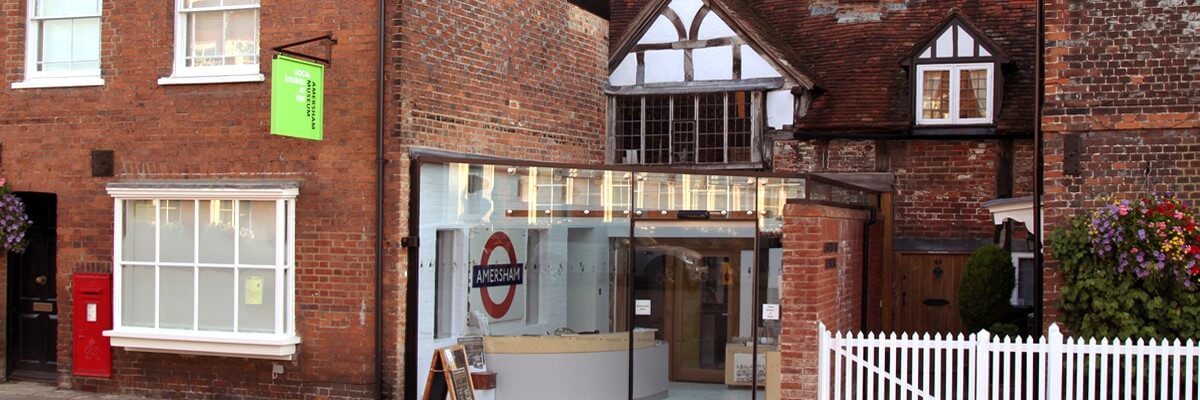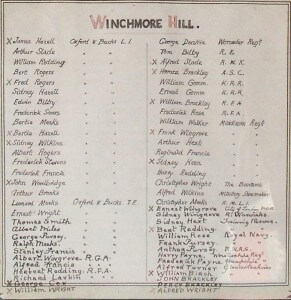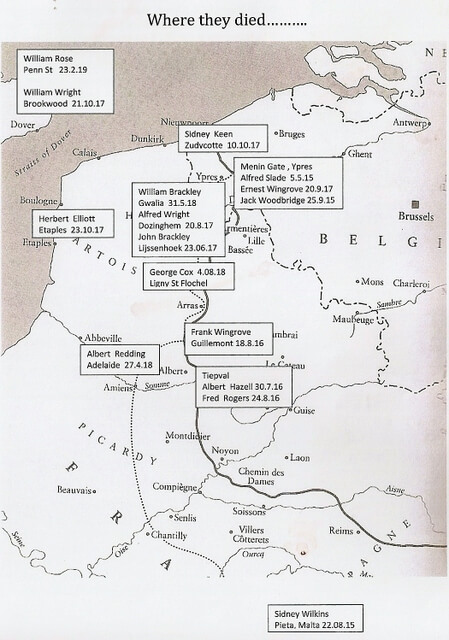The men from Winchmore Hill who died in the 1914/18 War
This page was researched and written by Stephen Palmer and Eric Miles
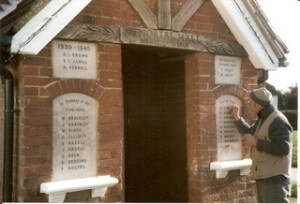
There are 18 names inscribed at the entrance to the Winchmore Hill Memorial Hall, which was opened on 27 November 1921, when memories must still have been very fresh and raw. There is also a second Memorial in the village, in the entrance to the Methodist chapel, and this lists all the 62 men from the village and surrounding area who fought in the ‘Great War’, with an asterisk marked for those who died.
These memorials show the devastating impact of the War on the village, as was indeed typical throughout Britain. The 1901 Census lists 64 household in the village, and from this census it is possible to identify 30 young boys who were later to fight in the 1914/18 war. (The memorials are dedicated to a wider area than just the village of Winchmore Hill itself, covering also outlying areas such as Mop End and Woodrow). So it seems likely that someone went to war from about 1 in every 2 households in the village, and sadly in one of every 5 households someone died.
Most of the men joined the Oxfordshire and Bucks Light Infantry or Territorial regiments, but there is a spread of other units as well, including the Royal Field Artillery and the Royal Garrison unit. Many volunteered at Aylesbury during the first flush of patriotic enthusiasm between August and November 1914, to be followed by some months of training in Britain before moving to the front. For those who died, it has been possible to identify the service-record of 16 of the 18 named on the Memorial, and their lives and deaths are further described below
Alfred Slade was born on 5 February 1896, one of eight children brought up by Alfred and Caroline Slade in one of the four Elm Tree Cottages on The Common. Alfred’s father was a chair-polisher, and Alfred was a farm-labourer. In November 1914 Alfred enlisted in the Royal West Kent Regiment which was transferred to France in April 1915. The regiment was soon involved in the First battle of Ypres, and Alfred was killed on 5 May 1915, with his name later commemorated on the Menin Gate.
Four months later a second man from Winchmore Hill was killed in the same area of battle and he is also commemorated on the Menin Gate. Jack Woodbridge lived at Horsemoor Farm, one of six children of James and Sarah Woodbridge. Also a farm-labourer, Jack enrolled in the Oxford & Bucks Light Infantry in September 1914, only a month after war had been declared. Transferred to France in May 1915, the 5th Battalion was heavily involved in trench warfare, and Jack died 25 September 1915, one of 463 casualties out of a total of 767.
Sidney Wilkins was the oldest son of George and Kate Wilkins, living at The Old Griffin, Mop End. Sidney was only 18 when he enlisted in the Warwickshire Regiment, 4th battalion, which landed in Gallipoli in July 1915. The regiment was immediately engaged in the battles of Kreithin and Archiban Heights. Sidney was injured and died of his wounds in Malta on 22 August 1915, where he is buried in the Pieta Military Cemetery.
Albert Hazell was born at Woodrow in 1898, the second of seven children of Walter and Mary Hazell. Walter was a cowman, and the family moved to The Row on The Hill, with the children attending Coleshill School. On 10 May 1915 Albert and a number of village lads enlisted in the Oxford & Bucks Light Infantry (2nd battalion). The following year the battalion was heavily engaged in the ill-fated Somme Offensive, including the battles of Delville Wood and Ancre. Albert was killed in action, aged 18, on 30 July 1916, and his name is commemorated on the Thiepval Memorial.
Frederick Rogers enlisted on the same day as Albert Hazell and into the same regiment. He was killed only a month later on 24 August 1916, and he is also commemorated on the Thiepval Memorial on the Somme. Frederick was born on 1 July 1897, one of five children to James and Alice Rogers. They lived at one of the Fagnall Farm Cottages, later moving to Elm Tree Cottages on The Common. Fred’s older brother, Bertram, was wounded in the war, but returned home safely.
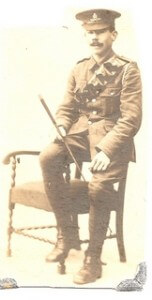
Frank Wingrove was the son of Albert Wingrove, a chair-leg turner, who lived with his wife Eliza in Royal Cottages on The Common. The 1911 census show the couple as having two single daughters, both in their 20’s who worked as bead-embroiders, and four teenage sons. All four sons enlisted in High Wycombe on 11 May 1915. Two sons did not survive the war. Frank Wingrove joined the Middlesex Regiment, but he was killed on 18 August 1916, aged 24, also during the Somme offensive. He is buried at the Guillemont Rd Cemetery.

Frank’s younger brother, Ernest Wingrove was one of six men from Winchmore Hill who died in the following year, 1917. Ernest worked as an under-kennel man. He originally enlisted in the Royal Warwickshire Regiment, and later transferred to the London Regiment, seeing action in Scarpe and Langemarck. Ernest became a Lance-Corporal, but died on 20 September 1917. Like two other men from the village, he is commemorated on the Menin gate. His younger and older brothers – Sydney and Albert- survived the war.

Horace Brackley (known as John) was the second oldest man commemorated on the Winchmore Hill Memorial to die – aged 36. He was a Windsor chair-maker, and lived in Coleshill, the youngest son of John and Fanny Brackley. He married Daisey Keen in 1902 and by 1911 they had six children living in Magpie Lane, Coleshill. He enlisted in the East Kent Regiment, and died on 23 June 1917. He is buried at the Lijssenthoek Cemetery near Poperinge in Belgium, and by that time his wife and family were living in Beckenham, Kent.
Two months later, on 20August 1917, Alfred Wright was killed in the same area around Poperinge, Belgium. Alfred was born in 1885 and lived as a child near to the Primitive Methodist Chapel in the Row on The Hill. He married Primrose Lacey in 1909, and by 1911 he and his wife were living in Tylers Green with a one-year old son. He worked as an Agricultural Labourer. He enlisted in the Warwickshire Regiment, but was killed and is buried at the Dozinghem Military Cemetery, Poperinge.
Three of the men listed on the Winchmore Hill Memorial died within the space of a fortnight in October 1917. Sidney Keen was born in Tylers Green in 1879. He married Eva Wingrove in 1900 and they had two daughters. Before marrying, Sidney had lived in the Queens Head Cottages in Whielden lane, though later he and his wife moved to Coleshill Lane. Sidney served in the Middlesex Regiment, but he was killed on 10 October 1917 and he is buried at the Zudycotte cemetery just east of Dunkirk.
Less than two weeks later on 23October 1917, Herbert Elliott died. Herbert was born in 1889 in Seer Green and lived later at Chalfont St Giles, working as a Labourer. In 1912 he married Lily Grace from Woodrow, and perhaps this local connection is the reason why he is named on the Winchmore Hill Memorial. Herbert was wounded in battle, and died and is buried at the Military Hospital at Etaples on the French coast.
William Wright was born in June 1891, the son of William and Kate Wright. In 1911 he was employed as a gardener and living in The Row with his parents and brothers. He originally enlisted in the Somerset Light Infantry, but later was transferred to the Royal Warwickshire Regiment, becoming a Lance Corporal. In July 1915 he married Violet Hardy and they lived in Clivia Villas, Coleshill. A daughter, Lesley, was born in the following year. William was wounded in Flanders, repatriated to the Brookwood Hospital in Surrey, but died of his wounds on 21 October 1917, and was buried at the Brookwood Military Cemetery.

Albert Redding was the youngest of six children of Herbert and Fanny Redding from Woodrow. He was born in 1899 and enlisted in Oxford with the Royal Berkshire Regiment, 2nd Battalion. He was killed in action on 27 April 1918, aged just 19 and is buried at the Adelaide Cemetery, Villers-Bretonneaux, Somme. Fanny and Herbert’s other three boys came safely home from the fighting.
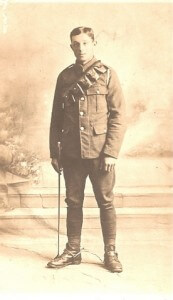
William Brackley, born on 15 April 1894, was the oldest son of William and Harriet Brackley In 1911 the large family were living in Horsemoor Lane, William a 16 year old farm-labourer with seven younger brothers and sisters. William enlisted with the Royal Field Artillery, but was killed in action on31 May 1918, and is buried at the Gwalia Cemetery, Leper, Belgium. Two of William’s brothers fought with the Gloucestershire Regiment, and returned home safely,
William Birch was born in Chesham in 1886, the son of Edwin and Sarah Birch. The family appears to have broken up, and the 1911 Census show William living in Coleshill Lane with his mother and two brother-in-law and a sister-in-law. He appears to have joined the Gloucestershire Regiment, but unfortunately no trace of his army-service or date-of-death has been found.
James Hazell was the oldest man in the village to die in ‘The Great War’. He was born in 1873, the son of James and Mary Hazell, and he worked as a General labourer. James enlisted in the Oxford and Bucks Light Infantry (92nd Battalion) but was later transferred to the Labour Corps (964th Agricultural Company) His service-record is unclear, but he appears to have been repatriated to England, dying of his wounds on 19 January 1919. He is buried at the Oxford (Botley) Cemetery.
George Cox was the only son of Joseph and Elizabeth Cox who lived on The Hill. He was born in 1882 and worked as a carpenter, while his father was a chair-bench worker. George married Edith Alice Perfect and by 1911 they were living in Twitchell Rd, Great Missenden with a one-year old daughter Ethel. On 4 December 1915 George enlisted at Aylesbury, and joined the Royal Engineers. As a Sapper, he had the difficult and dangerous job of digging a vast network of tunnels but during one of these operations he was wounded. He died on 4 September 1918 and is buried at Ligny- St Flochel, Averdoingt, Pas de Calais.
The last man from Winchmore Hill to die in World War 1 and the only one to be buried locally was William John Rose. He was one of six children of William and Cessie Rose living in Elm Tree Cottages on The Common. Born on 30 July 1892, William worked as a gardener and in 1911 he married Lily Redding, sister of another Winchmore Hill man killed in the war, Albert Redding. William enlisted in the Royal Navy and served as a stoker aboard HMS Pembroke. William’s ship was sunk, and he was repatriated home, but died on 23 February 1919. He is buried in Penn St Churchyard. His wife Lily lived on for a further 56 years, dying aged 84 and she is buried next to him in Penn St Churchyard.
These maps show where they lived and where they died.
The above information is principally based on war-records and an excellent web-site called ‘Buckinghamshire remembers’. Relatives of those who died have also contributed photos and memories, and their help is gratefully acknowledged.

